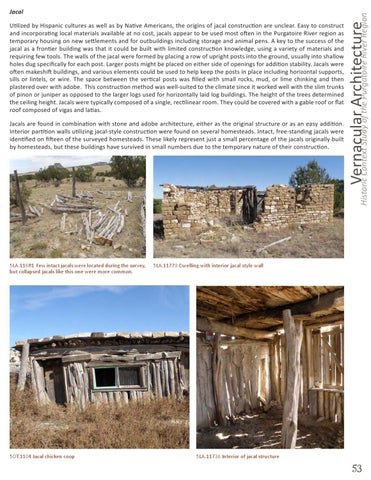Jacals are found in combination with stone and adobe architecture, either as the original structure or as an easy addition. Interior partition walls utilizing jacal-style construction were found on several homesteads. Intact, free-standing jacals were identified on fifteen of the surveyed homesteads. These likely represent just a small percentage of the jacals originally built by homesteads, but these buildings have survived in small numbers due to the temporary nature of their construction.
5LA.11681 Few intact jacals were located during the survey, but collapsed jacals like this one were more common.
5OT.1104 Jacal chicken coop
Vernacular Architecture
Utilized by Hispanic cultures as well as by Native Americans, the origins of jacal construction are unclear. Easy to construct and incorporating local materials available at no cost, jacals appear to be used most often in the Purgatoire River region as temporary housing on new settlements and for outbuildings including storage and animal pens. A key to the success of the jacal as a frontier building was that it could be built with limited construction knowledge, using a variety of materials and requiring few tools. The walls of the jacal were formed by placing a row of upright posts into the ground, usually into shallow holes dug specifically for each post. Larger posts might be placed on either side of openings for addition stability. Jacals were often makeshift buildings, and various elements could be used to help keep the posts in place including horizontal supports, sills or lintels, or wire. The space between the vertical posts was filled with small rocks, mud, or lime chinking and then plastered over with adobe. This construction method was well-suited to the climate since it worked well with the slim trunks of pinon or juniper as opposed to the larger logs used for horizontally laid log buildings. The height of the trees determined the ceiling height. Jacals were typically composed of a single, rectilinear room. They could be covered with a gable roof or flat roof composed of vigas and latias.
Historic Context Study of the Purgatoire River Region
Jacal
5LA.11779 Dwelling with interior jacal style wall
5LA.11736 Interior of jacal structure
53
